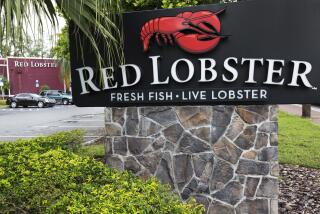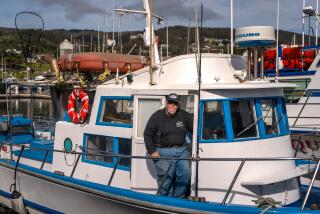‘Hanging On by Our Fingernails’ : Culinary Gold Rush Ends for King Crab Fishermen
- Share via
KODIAK, Alaska — A new joke began making the rounds here a year ago. It goes like this: A Seattle bank that had financed much of Alaska’s beleaguered crab fleet now offers you a choice of two gifts when you open an account. You can have a crab boat or a toaster. Crab fishermen advise you to take the toaster.
The joke is told with rue on this rugged North Pacific island, which heralds itself as “the seafood processing capital of the world.” It was here that men tied their fates to a prickly backed crab called the Alaskan king, a meaty, sweet shellfish whose population soared and whose popularity with diners seemed unshakable.
In the 1970s, the harvest was unprecedented. Deckhands poured champagne and snorted cocaine. Fishermen chartered Learjets. Retailers did a brisk business in earrings dangling with king crab teeth.
Forgotten were the lessons of a region where fortunes rise and fall at each new ripple of nature.
However, even as the harvests grew bigger and bigger, a shift of nature that some said originated as far away as the Equator had already begun to alter the ocean in a way that would bring this economy crashing down.
The Alaskan king crab’s population plummeted. The statewide catch, 195 million in 1980, collapsed to 90 million the next year and finally to 10 million this year. Crab fishing was prohibited altogether in Kodiak in 1982 and halted throughout most of the Gulf of Alaska and the Bering Sea in 1983.
“All of us in the fleet are just hanging on by our fingernails,” says Kodiak fisherman Harold Jones, 62. “My vessels have gone into bankruptcy.”
Biologists blamed a variety of events, varying from El Nino, a change in ocean currents that started at the Equator, to a crab disease compared in virulence to the bubonic plague. Even a herpes-related virus became a suspected culprit.
Fishermen themselves dismissed much of the scientific sleuthing and proposed their own theories. The most popular was that the crab was just hiding someplace.
The cause of the rich harvests that set off the boom was easier to trace. Biologists believe it began in 1972, an abnormally cold year in which the crab larvae flourished. By the late 1970s, the offspring had grown to adults and jostled each other on the crowded ocean bottom.
Word of the bounty spread and fortune hunters headed here and to Dutch Harbor, a Bering seaport where Kodiak fishermen had started a crab fishery, to cash in on the ocean’s offering. It was a culinary gold rush that was to turn both ports upside down.
Filet Mignon of Crabs
Cage after cage hoisted from the ocean floor brimmed with the enormous creatures, beloved as the filet mignon of crabs. Bells regularly sounded in harbor taverns, signaling free drinks for the house. Crab vessels rose fourfold in value and deckhands boasted earnings of more than $100,000 a season.
The money-flashing newcomers were not entirely welcome. Long-time Kodiak fishermen eyed them with disdain. They flinched when journalists attached the label “blue-eyed Arabs” to the newcomers. The old-timers disliked the competition and the dizzy spending seemed out of place. In Kodiak, residents were accustomed to distinguishing wealthy fishermen only by the kind of pickup trucks they drove or the number of snowmobiles in their yards.
Fisherman David Herrnsteen, 44, recalls with bitterness the financiers who arrived from New York and purchased crab boats as investments for doctors, lawyers and members of the film industry. They became known as “the absentees.”
Other fishermen, who would not otherwise have entered the business, took advantage of a government loan program to buy crabbers. Old-timers shake their heads as they recall the five fishermen who chartered a Learjet one weekend in Dutch Harbor to go to Anchorage to watch a football game.
‘Astronomical Profit’
Back then, though, the crab harvest seemed big enough and lucrative enough for everyone. Prices remained high even as the supply rose.
“The profit was absolutely astronomical for the fishermen,” says Richard Lauber, vice president and Alaska manager for the Pacific Seafood Processors Assn. “The king crab was a big deal. People loved it and they paid tremendous prices for it. It just caught on. I kept thinking personally that the market was going to collapse and people were going to rebel against the price, but it just kept going up and up and up.”
In 1981, biologists from the National Marine Fisheries Service here advised the community that the crab population was so low that the coming season was threatened. However, few believed the forecast.
‘Looked Pretty Drastic’
“I’m not even sure I believed it,” said Robert Otto, one of the scientists who made the prediction. “It looked pretty drastic then. We looked at the statistics a lot of different ways and it all came out the same. . . . And then when the decline started, it went twice as fast as we we expected.”
As the harvest dropped, the value of the crab vessels plunged. Boats valued at $2 million in 1979 might sell for $700,000 today. Fishermen who had purchased their vessels at the height of the rush when prices were high suffered the most. Insurance rates also began climbing, putting the final squeeze on skippers who could barely afford their boat payments.
The notice of boat seizures from the U.S. marshal’s office flowed into the headquarters of Kodiak Harbor Master George (Corky) McCorkle. He estimates that 80 to 100 crab vessels, known as crabbers, have been seized since the crash.
Crash Started in Kodiak
Fishermen also began having trouble paying their docking fees to the harbor.
“We’ve had to make some special arrangements to work out payments with a lot of the fishermen,” McCorkle said.
Fishermen estimate that 20% of the state’s crab fleet went under because of the king crab’s demise. The crash occurred first in Kodiak, the following year in Dutch Harbor.
“The banks were grabbing the boats quicker than the guys could get out of town,” recalls Greg Gerhardstein, facility superintendent for Sea Alaska Products in Dutch Harbor.
Torino Furgione, 52, is among those who lost their boats. The former deckhand mortgaged his home to buy the 101-foot Katrina Em in 1979. “I thought I would get another boat in a couple of years and retire early,” Furgione says.
Once Again a Deckhand
Instead, the Katrina Em dropped in value from $1.2 million to $400,000. Furgione said he could obtain only $400,000 worth of insurance but he needed $800,000 to satisfy his lender. He could not afford to convert the boat. After struggling for the last two years, Furgione finally lost his boat three weeks ago. He is once again a deckhand.
“Now, nothing’s safe,” he says quietly. “When they take the boat, they come after you for everything you have. I guess we’re going to lose everything.”
The bust was felt most widely in the canneries. They either shut down or substantially cut back hours. In Kodiak, about a fourth of the canneries eventually closed. In Dutch Harbor, four of six onshore canneries closed and 1,500 to 1,800 workers lost their jobs.
The shocks of the crash reached all the way to the lower 48 states. Restaurants in Los Angeles and elsewhere began removing the delicacy from their menus as the price soared, quality dropped and supply grew shaky.
A Boom for Scientists
What was a disaster for the fishing industry became boom for scientists. In the National Marine Fisheries Service laboratory here, the red king was dissected, infected and squared off against a predator, the octopus, in glass tanks.
“We virtually wrote the book on king crab pathology in the past few years,” Otto said. “We know what’s happening. We just don’t know why it’s happening.”
Otto called the huge drop in the crab population “totally unprecedented.””
“We’ve seen some pretty heavy crashes before but what is occurring here has basically been statewide. In all the areas, you are getting the lowest ever recorded abundance of the king crab. . . . One of the most frightening things about this is we don’t know how long we’re going to be where we are.”
Variety of Diseases
The biologists theorize that the crab was attacked by a variety of diseases when its resistance was down because of warmer water temperatures and shifting ocean currents.
“The decline occurred for all crustacean species in the Bering Sea--the blue king crab, the Tanner crab, what we call the Korean hair crab,” said Bradley Stevens, supervisory fishery biologist at the National Marine Fisheries Service here. “We’ve also seen it happen to the shrimp.”
The demise of the crab coincided with a boom in the population of halibut and cod, both crab predators. Fishermen who survived the crash converted their boats to harvest the halibut or used them as support vessels for salmon fishermen in the Bering Sea.
The canneries turned to processing surimi, an imitation crab made of flavored, processed bottom fish.
Surimi ‘Keeps Us Going’
“The only thing that really keeps us going is the surimi,” said John Sevier, plant manager of Alaska Pacific Seafoods in Kodiak.
Many fishermen still hope the crab will return. Although this year’s catch was only a fraction of the harvests of the good years, some fishermen said they noticed an abundance of juvenile crabs that will be of legal size for capture next year.
Kodiak fishermen continue to ply the choppy gray waters that surround the fog-shrouded mountainous island, and a few even report bigger earnings from the halibut than they ever made from the crab. There are even some who will argue that the rise and fall of the great Alaskan king crab was good for this fishing harbor.
“It’s been slim,” says Wayne A. Stevens, executive director of the Kodiak Area Chamber of Commerce. “You can’t downplay the significance of the decline. . . . But maybe its been good in that it has forced us not to keep all our eggs in one basket.”
More to Read
Sign up for Essential California
The most important California stories and recommendations in your inbox every morning.
You may occasionally receive promotional content from the Los Angeles Times.











